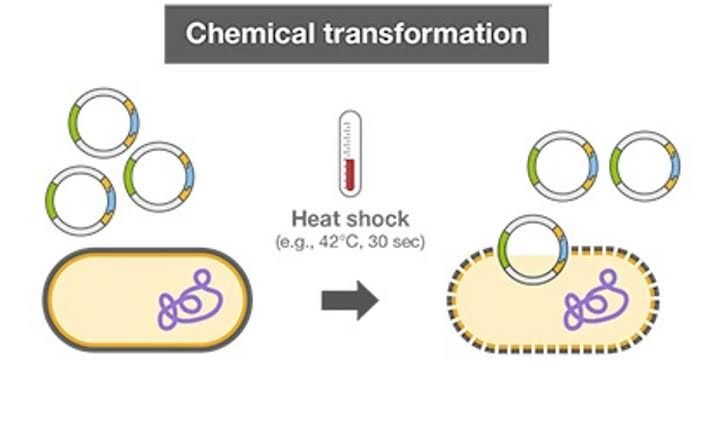
Preparation of Bacterial Competent Cells
Preparation of bacterial competent cells is a crucial step in the transformation process, allowing bacteria to take up foreign DNA, such as the pGLO plasmid. The following steps outline this preparation:
- Selection of Bacterial Strain:
- Typically, Escherichia coli (E. coli) is used due to its well-characterized genetics and ease of manipulation. The strain should be one that can be made competent for transformation.
- Growth of Bacteria:
- Start by inoculating a single colony of E. coli into a liquid growth medium (such as Luria-Bertani broth) and incubate it at 37°C with shaking until it reaches mid-log phase (optical density at 600 nm, OD600, between 0.4 and 0.9). This phase indicates optimal cell health and division rate for transformation.
- Harvesting Cells:
- Once the culture reaches the desired OD600, transfer the cells to centrifuge tubes and centrifuge at low speed (e.g., 4,000 x g for 10 minutes) to pellet the cells.
- Washing Cells:
- Discard the supernatant and resuspend the cell pellet in ice-cold calcium chloride (CaCl2) solution (typically 0.1 M). This step enhances the permeability of the bacterial cell membrane.
- Incubation on Ice:
- Place the resuspended cells on ice for about 30 minutes to allow them to become competent for DNA uptake.
- Final Resuspension:
- After incubation, centrifuge again to pellet the cells and resuspend them in a smaller volume of ice-cold CaCl2 solution or a glycerol solution (10% glycerol can be used for long-term storage). This final suspension can then be aliquoted into smaller volumes for future use.
- Storage:
- Competent cells can be stored at -70°C for several months if properly aliquoted to avoid repeated freeze-thaw cycles which reduce transformation efficiency.
Transformation with pGLO Plasmid
The transformation process involves introducing the prepared competent cells to plasmid DNA, specifically pGLO, which contains genes for green fluorescent protein (GFP) and ampicillin resistance. Here are the detailed steps involved in this process:
- Mixing Competent Cells with Plasmid DNA:
- Take aliquots of competent E. coli cells and add plasmid DNA containing pGLO (typically around 10-100 ng per reaction). It is important to use sterile techniques throughout this process to prevent contamination.
- Incubation on Ice:
- Incubate this mixture on ice for about 30 minutes again to allow plasmid DNA to associate with the competent cells without causing any stress or damage.
- Heat Shock Treatment:
- Subject the mixture to heat shock by placing it in a water bath at 42°C for approximately 30-60 seconds. This sudden temperature increase creates pores in the bacterial cell membrane, facilitating plasmid uptake.
- Return to Ice:
- Immediately return the tubes back to ice for another 2 minutes post heat shock; this helps stabilize the membranes after exposure to high temperatures.
- Recovery Phase:
- Add SOC medium (a rich nutrient broth) or LB broth without antibiotics to allow recovery and expression of antibiotic resistance genes from pGLO plasmid before plating on selective media.
- Incubate at 37°C with shaking for about an hour; during this time, bacteria express their new traits conferred by the plasmid.
- Plating Transformed Cells:
- After recovery, plate appropriate dilutions of transformed cells onto agar plates containing ampicillin (to select only those bacteria that have taken up pGLO) along with arabinose if you want GFP expression.
- Incubation of Plates:
- Incubate these plates overnight at 37°C; colonies that grow will either fluoresce under UV light if arabinose is present or remain non-fluorescent otherwise.
- Analysis of Results:
- After incubation, check colonies under UV light; those that glow green indicate successful transformation where E.coli has expressed GFP due to successful uptake and expression of pGLO plasmid.
In summary, preparing competent bacterial cells involves growing E.coli under optimal conditions followed by treatments that enhance their ability to take up foreign DNA like pGLO through heat shock methods, leading ultimately to transformed bacteria capable of expressing new traits such as fluorescence under UV light due to GFP production.







